
Miramichi Salmon: Where we are now, and what should be done?
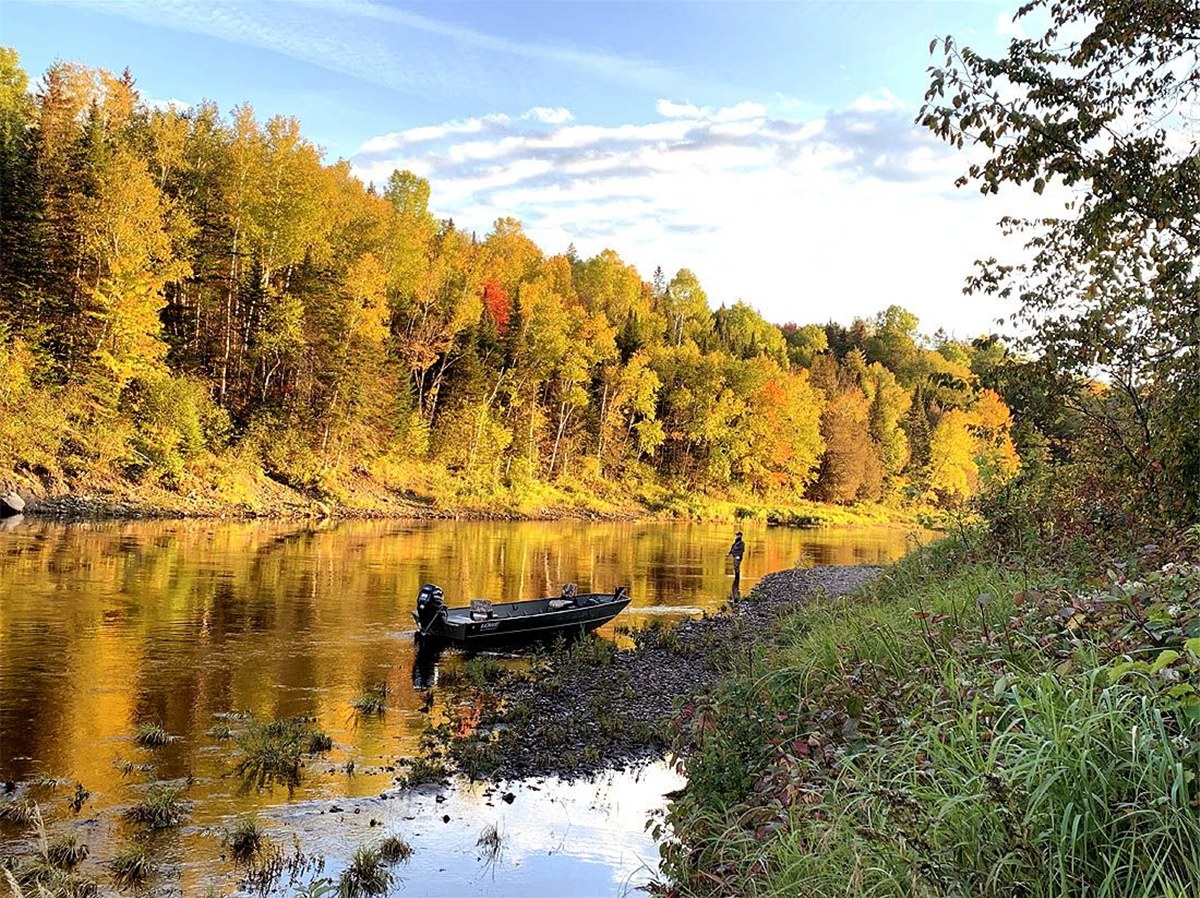
One of our special Christmas auction items is a jet boat tour of the Cains River with Tyler Coughlan of Country Haven.
This is the first of two blogs that I intend to get out in the fairly near future. This first one is largely to bring you up to date on what the experts that I’m talking to believe is going on with the salmon population of the Miramichi, and what needs to be done about it. I’m also going to kick off the Miramichi Salmon Association US fundraising season by letting you know about a Christmas auction that we are holding with a limited number of special items.
The second blog, probably to follow in a week or so, has a letter that I am sending to The Honorable Diane Lebouthillier, the new minister of Canada’s Department of Fisheries and Oceans. Like last year, when I wrote the previous minister Joyce Murray, I’m going to suggest/ask that you write this lady too. More on that in the next blog.
First, just for review, let’s talk again about how the Miramichi salmon season went. To say that the Miramichi’s 2023 salmon fishing could have been better is a considerable understatement, but still it did have its good moments. The run of fish that we experienced on the SW in late June seemed decent. I can tell you that I remember some late June fishing back in the early 2000s when there were not as many fish consistently available as there were in 2023. Whenever the water got down to a level when the fish would hold up long enough to get a cast over them we had decent catches. There were also some good days in mid and late summer too, in fact that part of the season was statistically a little better than most recent years. Rip Cunningham e-mailed me from Black Brook in late August, telling me that while it wasn’t quite like the good old days, fishing was pretty good.
The Miramichi fall run on both branches, however, was much weaker than the summer run – that’s actually a really big understatement. Clearly most of the fish that did return to the Miramichi in 2023 came in to the river early on the constant flow of high water. That was especially evident on rivers like the Cains where fish were regularly caught 18 miles up the river at Muzzerol in July. Most years that area doesn’t see any salmon until September. Still, the overall trap numbers – Millerton and Cassilis – for the entire season – along with personal observations by me and my fishing friends – indicated that the runs of salmon and grilse were far below normal. Some of that was the acknowledged high-water inefficiency of the traps, but the run in total was way down too, there is no denying it. For the most part the runs on the Gaspe and in Newfoundland were down this year also, so problems at sea didn’t help things at all.
While the trap numbers are important, we also have the barrier numbers to look at for additional verification. The Miramichi Salmon Association operates salmon barriers on both the Dungarvon River – which after merging with the Renous flows into the tidewater SW Miramichi at Quarryville – and the NW Miramichi. The barriers each sample only one small portion of both Miramichi branches, but they count every fish that swims through the barrier. This means that their counts are not subject to the interpretation required with the traps which only capture a small and variable percentage of the fish that run up the river.
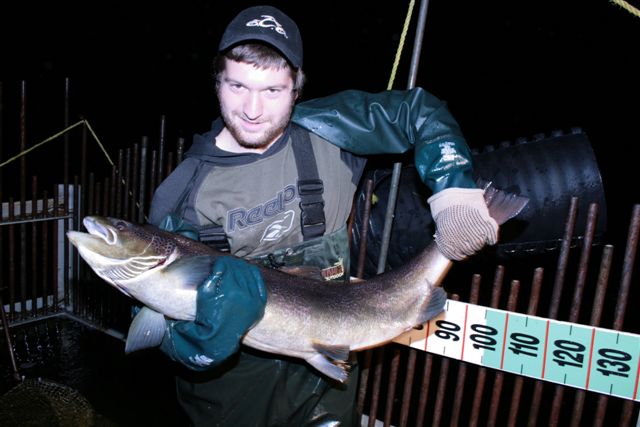
Night-time photo of a run of big fish hitting the barrier 20 years ago, in better days for the NW Miramichi.
In terms of salmon, the Dungarvon barrier counted 327 in 2011. In 2023 only 65 were counted. In 2011 the same barrier counted 712 grilse, and in 2023 the barrier came up with just 73. So since 2011 the Dungarvon barrier counts on salmon are down by 80%, but that’s better than grilse which are down by 90%. As terrible as those numbers are, the NW is even worse. They have gone from 298 salmon in 2011 to 50 in 2023, and grilse from 996 in 2011 to 16 in 2023. Those are declines of 83% and 98%. 98 is getting awfully close to 100! It reminds me of the countdown scene in the movie Independence Day when Jeff Goldblum, sitting on Airforce One, looks up from his laptop which is counting down to the alien invasion and says, “Times up.”
The loss of the Miramichi’s Atlantic salmon fishery seems unthinkable, but given the trend since 2011 it is possible. The world-famous Miramichi has long supported something like 90% of all salmon fishing trips taken in the Province of New Brunswick. Every year it is visited by fishers from all over the world. The importance of the Miramichi River to North American Atlantic salmon fishing simply cannot be overstated. So what can be done to stop any further decline and rebuild the run? Virtually all of the experts that we know contend that the central issue is the bloated striped bass population that is consuming unsustainably large percentages of the smolt runs in both branches of the Miramichi. When during the 1990s the striped bass population got down to an estimated 5K adults the DFO placed a complete moratorium on the fishery. The stripers sprang back, and while the fishery was closed in the early 2000s folks in-the-know were already experiencing terrific catch and release striper fishing at the mouth of the river. Salmon also were doing well in those years, proving that the two species can co-exist in some balance of reasonable abundance, and that people can enjoy good striped bass fishing in the Miramichi estuary on a lot less stripers than we have today.
When the DFO placed a moratorium on striped bass fishing they originally set a population target of 21,600 spawning bass then later increased it to 31,200. The bass population reached approximately 100,000 adults in 2010, and DFO biologist Gerald Chaput later stated that “the years when Striped Bass
spawner abundances exceeded approximately 100 thousand spawners corresponded to years with visibly lower estimated survival rates for salmon smolts.”
Estimates of the current striped bass population are thought to be between 300K and 1M. That is 3 to 10 times the level that Chaput said began to cause visibly lower smolt survival! Also, striped bass meaningfully impact all the other anadromous fish in the Miramichi such as smelts, gaspereau and sea run brook trout. Anecdotally they are also affecting the lobster fishery.
It seems clear that the striped bass population must be greatly reduced, and then kept at or below the 100,000 fish level. The striped bass fishing devotees will complain about this, but we aren’t asking for the 600,000 salmon the Miramichi system hosted in 1965. We are just asking for both populations – along with other anadromous fish – to maintain a reasonable population balance as they did as recently as the 2010 time frame.
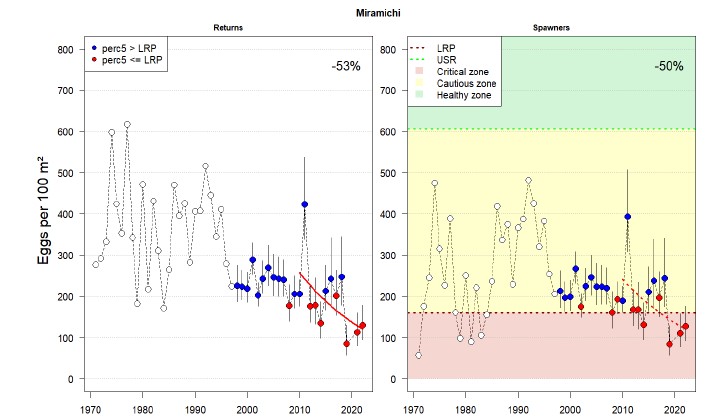
This graph from a recent DFO publication clearly shows that after years of solidly adequate egg deposition calculated from the size and number of returning salmon that the egg deposition has been in the critical zone for several years corresponding with the high bass numbers. It will not have improved in 2023.
John Bagnall with the New Brunswick Salmon Council created a great model that illustrates the effects of striped bass predation and several other relevant variables on the Atlantic salmon population of the Miramichi. Here is how the model shows that things looked on the Miramichi prior to the striper glut, in about 2011, when we had 71% of the smolts making it out to sea. You can see in Row 9 that we had a run of some 65K salmon and grilse. (# of Adults, Row 9) This left a surplus of some 18K salmon to absorb things like poaching, FN harvest and catch and release mortality, and hopefully to provide more eggs for the population to continue to grow. This era was what some of my friends now refer to as the “recent good old days.”
Note – double click the images and they will expand for easy reading.
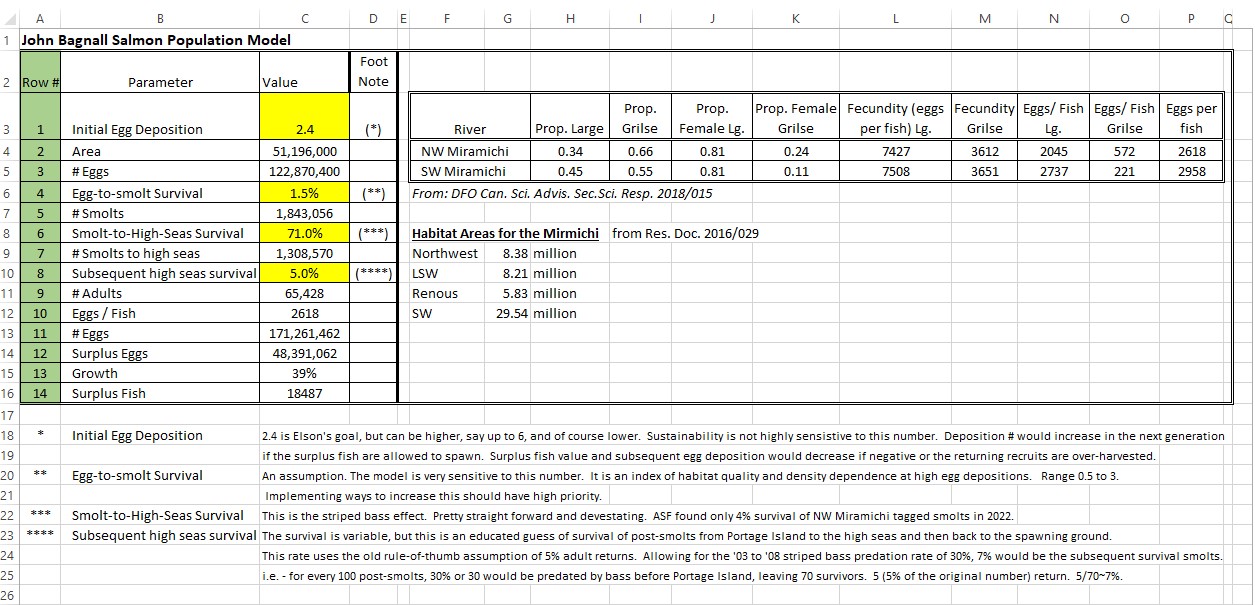
Here, unfortunately, is how things looked in 2022. They are much worse now. The run in the NW is in serious, immediate danger of extirpation. You can see in this spreadsheet that I have used a melded rate of 19.5% to describe smolt survival from the bass over the whole river. In 2022 it was 4% on the NWM and 27% on the SWM. I blended them to 19.5% using the respective habitat areas of each branch. When you run these data points you drop to a run of 10.6K salmon (down 85% from 65K) and you are then 18K shy of the individual fish needed to keep the population from sliding further. We are at least one year beyond what is portrayed in this illustration because we have been at these terrible levels of smolt mortality for the last two seasons. It is possible that any or all of the variables in the model can change, sometimes by quite a lot – things like sea survival, smolt mortality through the estuary, any of several aspects of egg to smolt survival – but the numbers I’ve used in this model illustration are either the latest data or time proven statistics from the Miramichi watershed.
There is a considerable danger in the salmon population getting too low, and part of that danger is a phenomenon called the Allee Effect. This bit of science dating back to the 1930s says that when population levels become too low it creates problems in an animal population. In salmon it could be too few smolts migrating to winter feeding grounds and losing the inherent security of moving en masse. Too few individuals can also make it difficult for salmon to find a mate. A population of only a few hundred individuals may be able to survive in a small Gaspe river with only a couple hundred yards of spawning gravel to populate, but in a comparatively immense system like the Miramichi where salmon can spawn in stretches of suitable gravel that run for many miles, the salmon may simply not be able to find others to mate with or even precocious parr to satisfy the male component. The Miramichi River needs to maintain a sizeable run of salmon, and the lodges, public pools and individual camps located throughout the 5,000 square mile watershed depend on a thriving salmon population too.
Are there other factors effecting the Miramichi that could be responsible for this decline instead of the bass? The answer is that there are other factors affecting the success of the salmon, but that does not change the catastrophic effect that the bass are having on the outgoing smolts. For one thing the smolts are being electronically tagged and monitored as they run down the river to the ocean. They do fine until they hit the areas of bass concentration, and then they are eaten. What about forestry practices, climate change, human development, low survival in the ocean? I stand by an earlier comment that not much other than the numbers of bass has changed in recent years. There are negative effects from all of these things, but they are considered by the biologists I know to be relatively minor, and they are little changed since we were doing well just 15 years ago.
Is warm water a big issue? Antóin O’Sullivan earned his PhD from UNB a few years back and has specialized in just this issue. He has uncovered some fascinating and important information about how salmon react to warming water. In doing his work he has studied water levels and temperature trends in the Miramichi since 1870 – the last 149 years. Some of what he found is included in the graphs below. I was struck by two things. First, the average high temperature for the summer has risen a grand total of .7 degrees C in the last century and a half. If you look at Sullivan’s graphics below you will also see that since the 1940s there has been essentially no change in June and July temps and only a very modest rise in August. In large part August is a much cooler month anyway, so that doesn’t seem to be much of an issue at all.
In another report written by Nova Scotian Mike Dadswell PhD he says that in Caesar’s time in Rome there were plenty of salmon acknowledged by the literature of the day. Temperatures then were 2.5C higher than they are today. Dadswell – from whom I have a handwritten 1980s letter about Canadian striped bass in my files – lays the overall salmon decline on what he calls IUU or Illegal, Unreported and Unregulated commercial fishing on the high seas. That may well be an important factor effecting all salmon populations. They are all in some state of decline, but no other river in Atlantic Canada has been hit anything like the Miramichi which previous to the bass explosion had stood very tall in the salmon world.
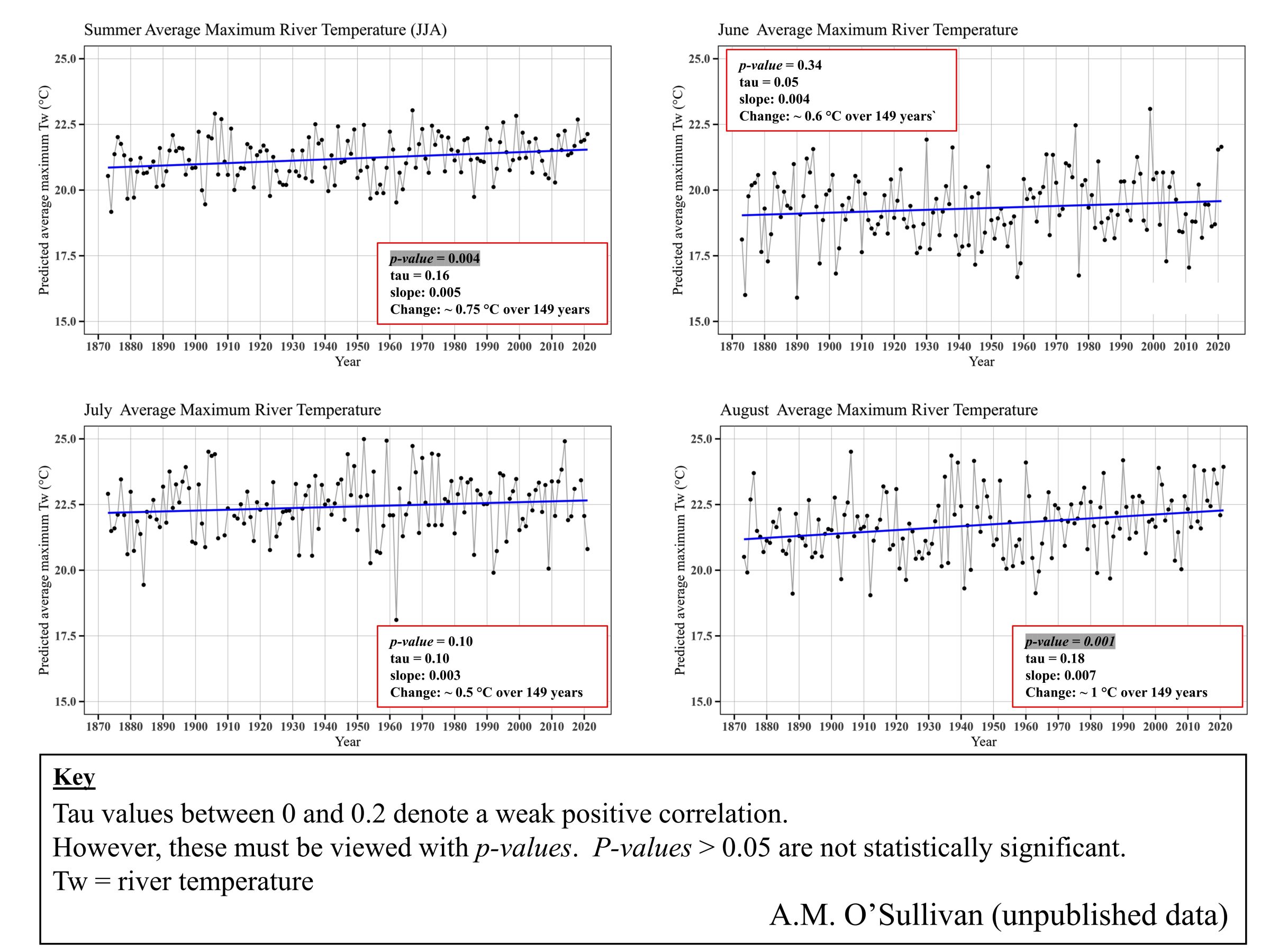
Four graphs by Antoin. You can see in the upper left-hand graph that the average maximum summer water temperature has changed only one half of a degree C since 1870 and only about half of that since 1950.
Will simply reducing the numbers of bass restore the Miramichi’s Atlantic salmon? Theoretically it should over time, but how much time? How much is the Miramichi already suffering from the Allee Effect? The only way to bring the bass population down quickly is to restore the commercial fishery and open it up starting in the spring of 2024. Having First Nations be the only allowed harvester isn’t going to work. Their quota of 50,000 striped bass annually has not been met in 5 years of having it available. Make the new quota a substantial one and allow the gaspereau netters throughout the Miramichi Bay and estuary to participate. Why shouldn’t they be allowed to do so? They already have the necessary gear and set locations, and there is a big, established market available in Boston. The fishery would be very lucrative. Alternatively, the bass would make a great supply of fresh native fish for the local NB populous.
An expanded commercial fishery is the only way to bring the current bass population down to the recommended level of 100,000 spawners, and it needs to happen in 2024.
An important part of the solution, according to all of the top salmon biologists that I am talking to is to supplement the Miramichi’s salmon population with the stocking of fry. There is a very clear track record of success with this technique. It was done in a big way on the Miramichi for well over 100 years, years when the Miramichi consistently had some of the greatest salmon runs in the world and the river was lined with outfitters and recreational salmon fishers.
With the runs down as they now are the broodstock utilized must be individuals gathered as wild smolts and grown to adulthood in the hatchery. Studies like this English study show that hatchery fry stocking technique will produce more than twice as many adult returns from the same number of eggs when compared to wild spawning. The stocked fry will live completely naturally and wild in the river for two years before smolting so their chances of going to sea and coming back as adults should be as good as the wild spawned smolts.
The Miramichi is still producing a diminished but reasonable number of wild smolts. At this point it is still possible to procure the needed numbers of these wild smolts and raise them in a hatchery. Actually a thousand female smolts – the river is producing hundreds of thousands – grown to adulthood would produce about 6M eggs which would eventually create about 12,000 adult salmon returns. This would be without consequence to the wild run because between the bass and survival at sea only about 4 percent would ever have made it back to the Miramichi anyway. What a plus that would be. This and even more needs to be done, and it needs to be done immediately! Bear with me for a letter to the new minister in a week or two.
Here are a couple of other announcements:
- Already underway is a special MSA Christmas auction. Like last year we are limiting it to just a handful of special items. We have a mounted 1932 map of the NW Miramichi, 150 gallons of heating oil from Dead River, a week vacation rental in a great waterfront house in Friendship,Maine, a jet boat tour of the Cains River with Tyler Coughlan, and a couple more items will soon be added. The auction will run until the evening of Dec 23. Check it out at this link Products | Brad Burns Fishing.
- Save the date of Feb. 3 2024 for the MSA US dinner and auction in Falmouth, ME. Special guest and speaker will be Sir Michael Wigan of the Helmsdale River in Scotland. It will be a great time. Tickets will be available for in person attendance or by zoom.
- Recently I donated $100 to the cause below. I hope you will read the following message from an old friend in fishery conservation work:
“Brookfield dams are degrading cherished and environmentally significant Rumford Falls, Aziscohos, and Ripogenus fisheries through their dewatering and peaking generation practices. The Federal Energy Regulatory Commission has given them a license to kill. Renewed licenses will be in effect for the next 40 years. Your opportunity is to seize this moment and fund our fight through a Legal Defense Fund. With your help, we can ensure these fisheries’ future. Please send your contribution to Maine TU Council, C/O Steve Heinz, 3 Spruce Lane, Cumberland Foreside ME 04110. Trout Unlimited is a 501(c)(3) organization.”
Thanks for reading. Brad Burns


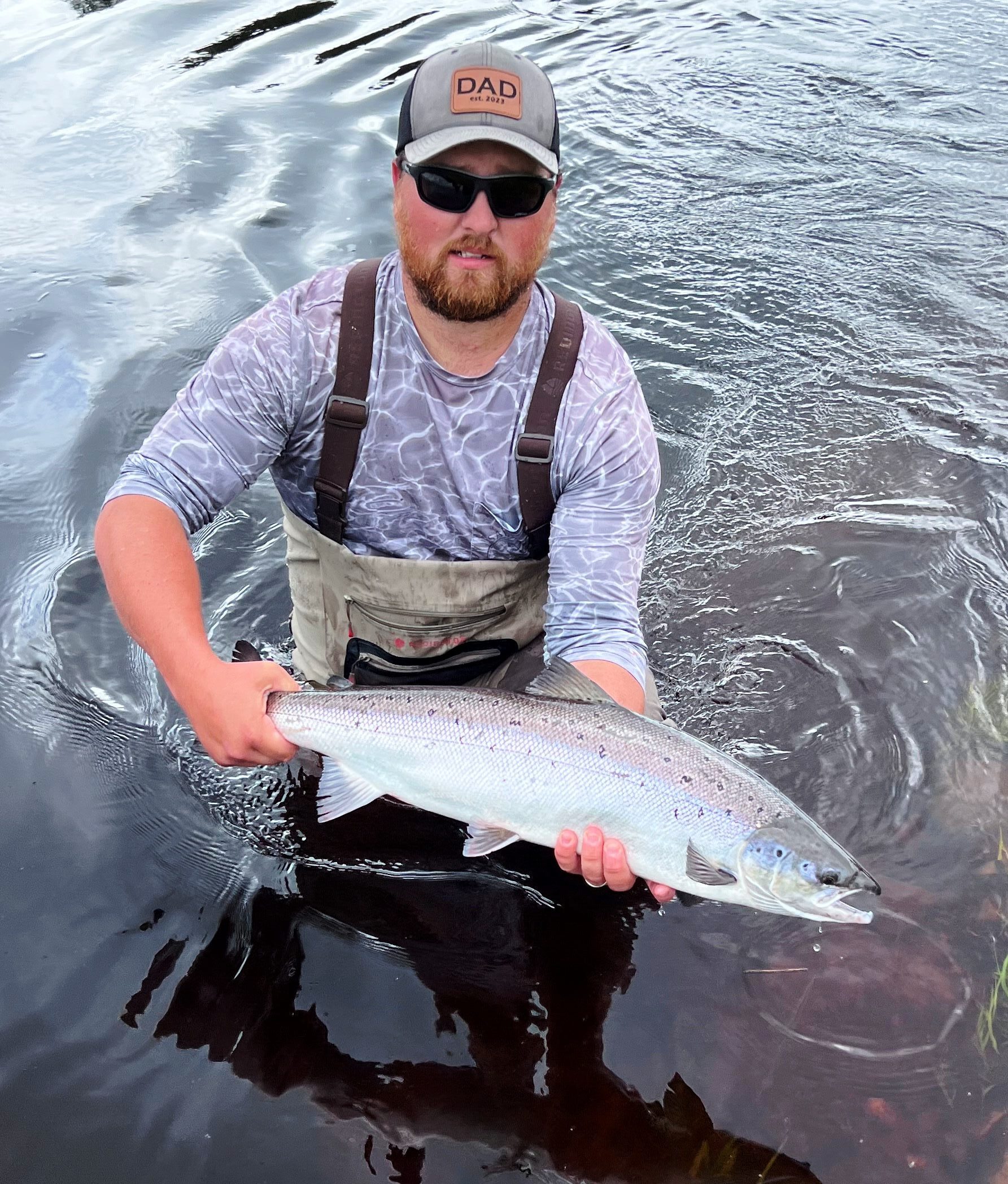
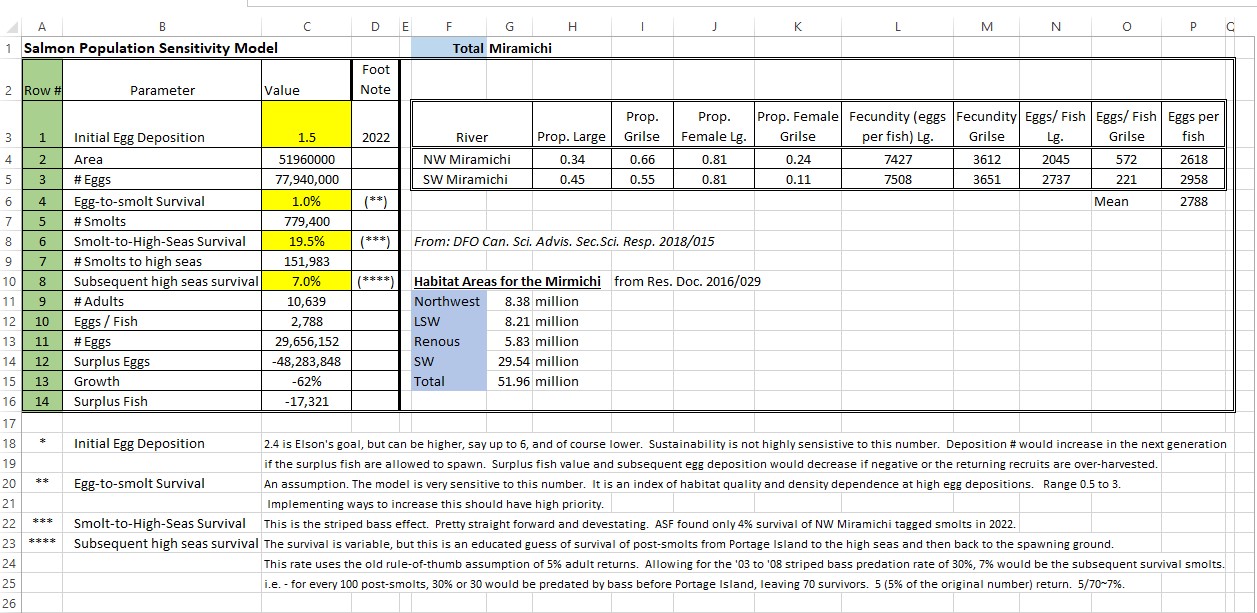
Hi Brad. Thank you for another detailed letter that expresses real concern about AtLantic Salmon on the Miramichi.
Good luck with your letter to Minister LeBouthier. I wrote to her expressing these concerns and asking specific questions in early fall. It took 2 months to receive a response. The response was from her Senior Assistant. Half of his response was thanking me for my letter and reiterating what the purpose was of the Ministers report published in.late summer. Not one of my specific questions was addressed.
I’m trying to remain hopeful that those in charge will actually take significant action, but…..
In fact, the only organization of the ASF, MSA, and Ministers office that has addressed some of my specific questions was the MSA.
Will measures be taken to reduce the numbers of striped bass?
Will the number of fry/Parr from brood stock that are used to stock the Mirammichi be greatly increased?
Will the Super smolt program be implemented?
Will the truck the smolts past the bass program be implemented?
Orrrrrtt…. will the Mighty Miramichi fade away to become a striped bass and tubing river
Bob
Bob – I sure do share your concerns. Right now the MSA, ASF and FN are working together to convince DFO to reduce the bass. It is a vital step and will hopefully be effective. The ASF has not been a supporter of the need to stock fry to supplement the stock. Stocking fry is something that essentially all of the biologists that I have been speaking with are adamant is necessary to help get us out of this hole. After the stocks have recovered a healthy program of stocking fry in areas that for one reason or another have low fry and parr counts will help in providing a good fishery. This has been done for well over 100 years, and they were great years for the Miramichi.
Probably the best article I have read that is based on hard FACTS!! Great job Mr Burns. I totally agree that the number of bass is far too high in the Miramichi river system and if DFO doesn’t do something VERY SOON it may be too late-I sure hope I’m wrong. I remember catching a small striped bass maybe about four pounds max here in Red Bank prob 17-18 years ago As I was getting the small bass close to the boat it spit out a small fish with a green tag on its back which I recognized as tagged salmon smolt as the smolt wheel on the little southwest was just a few kms upriver I’m front of Debbie Nortons camp. Anyways when I got the bass in the boat I noticed another tagged smolt in the bass’s mouth. I had hooked the bass deep and it was bleeding profusely so I kept the fish to take home even though the recreational bass fishery was closed at the time but as a native I believed I was not fishing recreationally I was fishing for food so I kept the bass. When I got home and cleaned the small bass I noticed that its stomach had quite a few fish inside it. I sliced its stomach open and inside were three more partially digested salmon smolts-the only way that I could really identify them as smolts were that they were all tagged on their back with the small green tag. I laid the one smolt that had come out of the stripers mouth beside its mouth to show that it had come from inside its mouth and laid the other three partially digested tagged smolts along it’s cut open stomach to show they had been inside the bass and explained that one other tagged smolt had fallen out of the stripers mouth at boat side. I sent this pic into dfo in. Moncton at the time to express my concern that if this one small striped bass had eaten six salmon smolts imagination how many salmon smolts are being eaten each year when the smolts are heading down river through a huge schools of hungry stripers. And the number of stripers was increasing dramatically each year. DFO answered me and said they felt my photo was a staged photo and something to the effect that I was trying to over dramatize the amount of salmon smolts that striped bass were eating. I was pissed. Like where the hell was I going to get a bunch of tagged salmon smolts that were partially digested to make a staged photo. I later gave this photo to Jim Laws at Miramichi electronics and he later sent it to dfo who accepted it !!! A couple years later I was hired by the Red Bank First Natiom(2010-2014) as their Director of Natural Resources and remember a meeting in Red Bank where I was talking which Gerald Chaput from DFO and told him the rapidly growing striped bass population was not only having an effect on salmon smolts but on salmon parr as well due to the fact that striped bass were been caught a lot further upriver each season. I’m a meeting he told me that this was not a big concern as striped bass did not venture much further upriver than the head of the tide!! I told him are you serious??!! I asked him if there was a stop sign under the water at the red bank bridge that says no striped bass behind this point????? We all know he was most definitely wrong as striped have been caught up to and past the whereton bridge on the northwest during the past couple seasons and I personally saw a small striped bass caught at Calls pool which is just above the Miners bridge on the northwest. There are striped bass that holding in the deep cold water of the million dollar pool(big hole) in Curventon as well. I have fished the northwest and little southwest all my life, guided on the little southwest, northwest and Man southwest for over 30 years, worked as a fish warden here in Red Bank for about 10 years, worked as the director of natural resources here in Red Bank(2010-2014) and been guiding for striped bass here in Red Bank from 2015 so I feel I know this river as well or better than most so no one is going to tell me that striped bass are not having a huge negative impact not only on salmon smolts but on salmon parr as well!
Thanks for writing Norman. I think DFO knows it now. The question is just what will they be willing to do about it and when. First Nations and some of the recreational groups are working together now to try and get a plan in place. I’m sure something will be done. I just hope that it is the right stuff and enough of it.
Hi Brad:
This blog report is excellent, but for at least the past 10 years I have been hearing (and repeating), that the explosion of striped bass is a crisis that DFO must urgently address. You do not mention anything about why they do not respond. Does it just come down to an ideology that nature should be left to sort itself out? If so, what is the justification? Is everyone shell shocked after the collapse of the smallmouth bass eradication project? Is it a carryover from the mismanagement of the commercial cod fishery? Does the resistance result from a powerful lobby of recreational striped bass fishermen? It seems futile to continue sending increasingly urgent pleas to a department that seems to ignore them. We need to be demanding an explanation so we have something to grapple with.
Thanks for all of the work you have put in.
Bob Thomson
I’ll sound like the old, political conservative that I am, but the most vulnerable position we can be in is to have to depend on the government for our salvation. The smallmouth bass fiasco is a very good example. The government went so far as to spend millions of dollars only to abandon the program at the finish line. It is a story that a rationale person can hardly believe. In 2010 things looked so rosy, but the warning signs were there shortly afterwards as the smolt mortality in the estuary began to creep up. If a welll managed commercial fishery had started then we would have a much different situation today. There still would be bass and the salmon runs would have continued to be good.
Brad,
Thanks for your great work to highlight the seriousness of the conditions on the Miramichi.
It is a shame that government agencies do not recognize that precious resource of the Miramichi salmon population
As the unique treasure that it is. Hopefully, you and other will open there eyes.
Thanks for your comments Rick. There are cultural changes with succeeding generations, and I’m afraid that some of the younger fishers and biologists don’t have a full appreciation that for what salmon fishing means to the Province. There are many that do, though, and I hope that in the end we’ll turn the tide.
Hi Brad
Just read your report which is very interesting
I made my first trip to Miramichi in June this year and you kindly gave us some advice beforehand, unfortunately when we arrived the river was in flood and we only caught 1 salmon between 3 of us but lots of striped bass. The bass are good sport and in a way saved the week for us BUT THEY ARE NOT SALMON!
We stayed at Country Haven and Byzie and his team couldn’t have tried harder to make us welcome and catch us salmon but I fear that if things continue as they are they will have to promote bass fishing to survive
I can’t help but compare this to the Tweed in Scotland and some Norwegian where we fish regularly, no bass there but similar problems – no fall run since 2013, increased predation by seals in tidal reaches and avian predators on smolts in the upper river, and commercial fish farming in the estuaries which spread parasites and disease to the wild population.
The only common factor is that all our salmon return to the Atlantic and I do believe problems there in rising water temperatures and commercial overfishing which denudes the salmon’s food sources contribute to declining survival rates.
Interestingly salmon runs and catches in Iceland are holding up pretty well, the difference there is they have hatchery programmes and most rivers are stocked regularly.
There is no simple answer, each river / country has its own specific problems and there are a few common ones, but unless action is taken to address these I fear there will be no salmon fishing for future generations
Best Regards
David Searson UK
I’m glad that you enjoyed your trip last year. The high water kept up most of the season, and that didn’t help with the catching. Hopefully it was a good year, though, for the salmon. The high water may have reduced normal levels of fry and parr mortality simply by giving them more water to obscure them from predators.
I fear that the DFO staff may not understand salmon fishing well enough to realize that bass are not a substitute for salmon. The bass do provide good fishing in the estuary and lower river for a period in the early part of the season and at the very end. The salmon provide good fishing up almost every branch of the system, and in many cases this good fishing extends over three or four concentrated months and runs up to almost 100 miles inland. This consistently available fishing is what all the lodges, crown reserve stretches and individual camp owners thrive on. Stripers on the other hand go out to the ocean for the summer and provide no fishing to speak of above the head of tide. The salmon kelts also provide an additional month of early spring fishing that many enjoy. They are essentially the only game in town from mid April to mid-May.
The same people who let the cod die in Atlantic Canada are still in charge, we must get rid of the fiberals if any change is needed. I have not fished salmon since we were not allowed to keep them, why would anybody, so I fish the sea trout on the river now. You have to be there to get one, very rare indeed…
Thanks for your comments Ken, though I must say that I enjoy salmon fishing, and if I can’t keep one it is not a problem for me. The bass are definitely a problem for the sea run brook trout. The sea run brook trout runs are down almost as much as the salmon – as are the smelts and gaspereau – thanks to the bass.
After fishing on the MSW, the St John and the Nashwaak Rivers since the 1960’s, I had the pleasure of fishing, keeping a few, releasing hundreds of salmon. Unfortunately all three rivers are at risk as are the BC rivers that have steelhead and chinook salmon. We do need political action if we are going to reverse the trend. If the MSA wants to address the problem quickly, then the Department of Fisheries is the wrong access point. I would suggest we ask the New Brunswick MP Dominic LeBlanc to intercede on your behalf as he is much higher up on the food chain and should weld more power and another would be to get the Indigenous people involved with the preservation of the salmon and to lead the attack on stripe bass. But you need to get the people of New Brunswick involved in the fight. An interesting stat would be the charting the decline in resident salmon fishing licenses sold against the apathy within the DFO. I did write to the Salmon Association last year suggesting that one of more hatcheries be built for radically increase the number of salmon returning to our rivers and we could tag many of them with a catch and keep tag. At the same time the MSA members should allow the public to fish their non holding pools when the pools are not in use. A side benefit of the hatcheries would be the employment of the local residents.
Does anyone know the results of the experiment of raising wild NWM salmon smolts to adults in pens worked? That would provide a quick fix to while the longer term solutions take hold. Good luck and a final question.
Is it worthwhile to take my granddaughters (ages 11 & 13) down east salmon fishing in 2024 or should I think about taking them to Vancouver Island to fish for pink salmon? They are both avid fly fisherman and the oldest actually ties her own flies including the green machine, undertaker, and samethingmurray.
Steve – sorry, again I somehow missed this post. There is a lot in your post. I can assure you that people involved with the MSA in NB have tried and are trying to work with Dominic LeBlanc.
Growing wild smolts up to adult broodstock is a timely and necessary solution. there just aren’t enough adults left in the run to remove them as broodstock. They should be allowed to spawn wild. Between the bass and ocean mortality far less than 1% of smolts live to return as adults. Taking these wild fish, growing them for two years in the hatchery and then spawning them is the way to get fry that are arguably the same as will fry – certainly their genetics are perfect. Thesefry then live for two years completely wild and natural before smolting. This certainly appears to be one good way to go.
I may be prejudiced, but I love fishing the Miramichi.
The DFO appears to have made a populist political decision — in favor of a species that the public can fish for anywhere, and can kill and eat, and against a species (they see as) favored by rich people who live elsewhere, ply private water, and fish mainly for fun. Sad and seriously short-sighted. The biologists have been co-opted by the politicians. Happens elsewhere, too: witness the clear preference for non-native Lake trout in Maine’s Sebago Lake. In NB, the DFO tipped its hand a few years ago when it vetoed the SARS program (after first approving it), and the ASF didn’t help when it insisted, naively, on natural reproduction only. A temporary smolt-to-adult stocking program may now be the only hope for returning to naturally reproducing salmon. That and reducing the bass population ASAP, of course. In short, the DFO may be incompetent, but it appears to know exactly what it is doing — thinking of local voters rather than caring for native fish.
Jim – please see what I wrote to Roger Earle, it applies here too. I would add that there is almost a hysteria among a portion of the scientific community that purely wild in every finite detail is the only path forward. There are a lot of other and usually more experienced biologists who disagree with this view. The reality is that all over New Brunswick and Prince Edward Island we are trying to rebuild extirpated salmon stocks. Stocking is the only possible way to do it. DFO has to see that doing some of that stocking to supplement still viable populations – like the Miramichi – is a much more sensible course of action. Brad
Hi Brad,
Thanks as always for your efforts to drive home the need for change in government policy on the Miramichi. The economic impact on the province with the decline in salmon numbers cannot be understated, as there are many who are not striper fisherman.
Thanks again
Roger Earle
Roger – I couldn’t agree more. One knowledgeable Canadian I know says that the issue is that the young DFO personnel have no connection to salmon fishing. License sales in NB are made by the Provincial DNR so the fishery means nothing to DFO from that standpoint. I think that they see a ton of people out on the estuary in late May bass fishing and figure that has to be way more than the salmon fishing participation. They are missing the fact that on any given day from early June to October 15 there are hundreds of people lining many hundreds of miles of shorefront on all branches of the Miramichi, and that the only fishing action in April and the first half of May is for salmon kelts and brook trout. I have other NB friends who insist that DFO has not intentionally prioritized striped bass over salmon, and that DFO has simply been wrong about where these super strict bass regulations would eventually take us. I think DFO is going to get an education on these issues from all sides this winter. Brad
Had to jump in again, Brad. Why in the worl
d would the ASF NOT support stocking fry? It seems some of these organizations that claim to have ‘protection and enhancement’ as a mandate are forgetting the ENHANCEMENT part of the equation. What does the ASF want A PRISTINE BEAUTIFUL RIVER WITH NO SALMON IN IT? They need to give their heads a shake. No wonder i couldnt get a direct answer from the ASF on their position on stocking. Everyone wants to blame DFO (and they must take the bulk of the arrows) but cmon the ASF can’t even agree with the MSA about putting some darn fish in the river. Frustrated with these groups!
I should not get going here on ASF because the MSA, ASF, FN and the NBSC are all trying to work together to make a path forward. I hope to god it works. While the ASF has been opposed to stocking there are some within ASF who see the potential benefits and know that it is necessary if we want to fish for salmon. I hope for the good of the Miramichi that the ASF position becomes more realistic.
Brad, I just returned from Mountain Channel camp yesterday (10/12/24) after a week of fishing on both the big river and the Cains for one day when the big river rose 18 inches (unfishable). This was my second trip to the camp in the last six years and I must say while we saw some fish in the channel this time around my brother and I were shut out while our friend landed one 4 lb grilse the first evening, and nothing after that. We maybe saw one fish the next three days. I calculate I cast my fly 6,152 times over four days to no avail. Now I agree we’re not asking for 1965 salmon population levels but something must be done to increase the numbers. Otherwise people like me, my brother and my friend will think twice about driving 800 miles up and 800 miles back to Pennsylvania and spending more than $6,000 to do so only to come up dry. Don’t get me wrong, the experience is great, the river is beautiful and the guides are very knowledgeable and great to talk to. I pine for days when you could walk down to the river, drop a fly in and on the second or third cast a fifteen pounder was on you line. I realize bringing the numbers up is a complex issue, but I hope the powers to be act quickly to reverse the trend. If not, and as one of your readers so aptly said, the fabled Miramichi River will become a striped bass fishery and tubing river within the next ten years.
Bob – I don’t know how I missed this message, but somehow I did. I, and lot of folks very connected to the Miramichi share your concerns. In 1965 the run was over a half million fish. Yes, those days are gone for the imaginable future. In 2011, though, we had almost 100,000 and it was a very exciting fishery. We probably had more really large fish than they did in 65 when there was an active net fishery. We have been screwed by DFO’s blind ambitions to populate the Gulf of Saint Lawrence with Miramichi stripers. They haven’t backed off it much yet, but we are going to take every possible step including going to court is going to be used to try and change things.